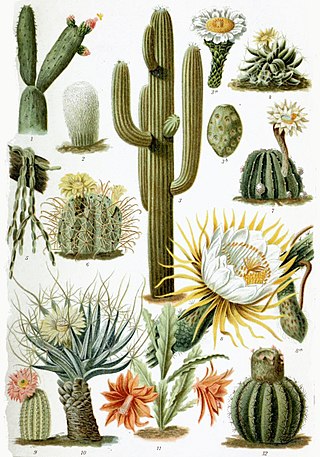
A cactus is a member of the plant family Cactaceae, a family comprising about 127 genera with some 1,750 known species of the order Caryophyllales. The word cactus derives, through Latin, from the Ancient Greek word κάκτος (káktos), a name originally used by Theophrastus for a spiny plant whose identity is now not certain. Cacti occur in a wide range of shapes and sizes. They are native to the Americas, ranging from Patagonia in the south to parts of western Canada in the north, with the exception of Rhipsalis baccifera, which is also found in Africa and Sri Lanka. Cacti are adapted to live in very dry environments, including the Atacama Desert, one of the driest places on Earth. Because of this, cacti show many adaptations to conserve water. For example, almost all cacti are succulents, meaning they have thickened, fleshy parts adapted to store water. Unlike many other succulents, the stem is the only part of most cacti where this vital process takes place. Most species of cacti have lost true leaves, retaining only spines, which are highly modified leaves. As well as defending against herbivores, spines help prevent water loss by reducing air flow close to the cactus and providing some shade. In the absence of true leaves, cacti's enlarged stems carry out photosynthesis.

Sorrel, also called common sorrel or garden sorrel, is a perennial herbaceous plant in the family Polygonaceae. Other names for sorrel include spinach dock and narrow-leaved dock.

In botany, a bulb is a short underground stem with fleshy leaves or leaf bases that function as food storage organs during dormancy. In gardening, plants with other kinds of storage organ are also called ornamental bulbous plants or just bulbs.

Juncaceae is a family of flowering plants, commonly known as the rush family. It consists of 8 genera and about 464 known species of slow-growing, rhizomatous, herbaceous monocotyledonous plants that may superficially resemble grasses and sedges. They often grow on infertile soils in a wide range of moisture conditions. The best-known and largest genus is Juncus. Most of the Juncus species grow exclusively in wetland habitats. A few rushes, such as Juncus bufonius are annuals, but most are perennials. Despite the apparent similarity, Juncaceae are not counted among the plants with the vernacular name bulrush.

Scheuchzeria palustris, is a flowering plant in the family Scheuchzeriaceae, in which there is only one species and Scheuchzeria is the only genus. In the APG II system it is placed in the order Alismatales of the monocots.
This page provides a glossary of plant morphology. Botanists and other biologists who study plant morphology use a number of different terms to classify and identify plant organs and parts that can be observed using no more than a handheld magnifying lens. This page provides help in understanding the numerous other pages describing plants by their various taxa. The accompanying page—Plant morphology—provides an overview of the science of the external form of plants. There is also an alphabetical list: Glossary of botanical terms. In contrast, this page deals with botanical terms in a systematic manner, with some illustrations, and organized by plant anatomy and function in plant physiology.

Juncus articulatus is a flowering plant species in the rush family Juncaceae. It is known by the common name jointleaf rush or jointed rush, which can also refer to J. kraussii from Australia. It is native to Eurasia, Canada, Greenland and much of the United States. It grows in moist areas, such as wet sand, and thrives in calcareous soils. J. articulatus was found to be more sensitive to drought and salt stress than its congeners J. acutus and J. maritimus. It is a perennial herb producing mainly erect stems from a short rhizome. The stem may root at nodes, and it generally has one or more flattened hollow cylindrical leaves up to 10 centimeters long. Transverse internal partitions or joints may be seen or felt in the leaf of the plant.
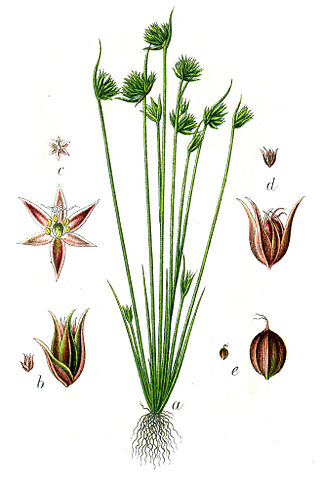
Juncus capitatus is a species of rush known by the common names dwarf rush and leafybract dwarf rush. It is native to Europe, Asia and North Africa. It is also an introduced species in parts of North America such as California and the Gulf Coast. It grows in moist areas, such as wet sand, vernal pools, and ditches.

Juncus mertensianus is a species of rush known by the common name Mertens' rush or Alaska rush. It is native to much of western North America from Alaska to Saskatchewan to New Mexico, where it grows in wet mountainous areas such as riverbanks and alpine meadows. This is a clumping perennial herb growing from a vertical rhizome. Its smooth, flat stems grow to a maximum height near 40 centimeters. Its few leaves are located at the base and also along the stem. The inflorescence is made up of usually one cluster of many flowers. Each flower has shiny dark brown to black tepals 3 to 4 millimeters long, six stamens with yellowish anthers, and long reddish stigmas, as in image at left. The fruit is a dark, oblong capsule, as in image at right.
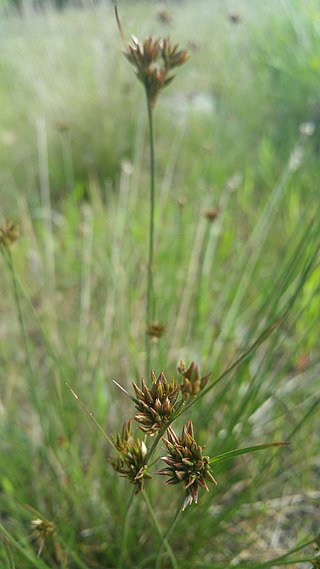
Juncus occidentalis is a species of rush known by the common name western rush. It is native to the western United States, where it grows in wet areas in many types of habitat. This is a bunching perennial herb with thin, stiff stems reaching maximum heights between 30 and 60 centimeters. The wispy leaves grow from the base of the stem and may approach half the stem's length. The inflorescence holds loose bundles of individual flowers and there is usually one long, leaflike bract extending far past the flowers. Each flower has green-striped brownish to reddish tepals each several millimeters long, and six stamens with small anthers. The fruit is a brown capsule which grows encased within the tepals.

A stem is one of two main structural axes of a vascular plant, the other being the root. It supports leaves, flowers and fruits, transports water and dissolved substances between the roots and the shoots in the xylem and phloem, photosynthesis takes place here, stores nutrients, and produces new living tissue. The stem can also be called halm or haulm or culms.

Juncus breweri is a species of rush known by the common name Brewer's rush. It is native to western North America from British Columbia to northern California, where it grows in coastal habitat such as beaches and marshes. It is a perennial herb growing from a tough rhizome which anchors it in sand and other unstable substrate. It produces slender stems up to 1.3 metres long. The leaves are bladeless and are reduced to dark brown sheaths around the stem bases. The inflorescence is a cluster of flowers emerging from the stem and accompanied by a single long, cylindrical bract which looks much like an extension of the stem. The flowers have purplish brown and greenish segments a few millimeters long.

Juncus covillei is a species of rush known by the common name Coville's rush native to North America.
Juncus kelloggii is a species of rush known by the common name Kellogg's dwarf rush. It is native to western North America from British Columbia to California, where it grows in low, wet spots in meadows and other grassy areas, for example, vernal pools.
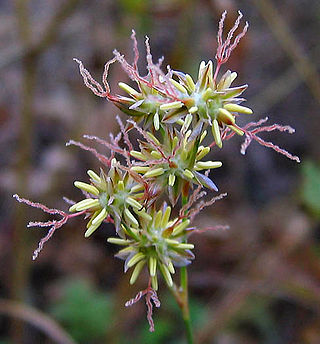
Juncus macrophyllus is a species of rush known by the common name longleaf rush.
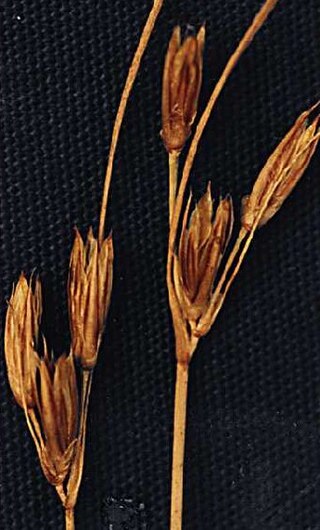
Juncus parryi is a species of rush known by the common name Parry's rush. It is native to western North America from British Columbia and Alberta to California to Colorado, where it grows in moist and dry spots in mountain habitat, including rocky talus and other areas in the subalpine and alpine climate. This is a rhizomatous perennial herb producing a dense clump of stems up to about 30 centimeters tall. There are short, thready leaves around the stem bases. The inflorescence is a cluster of flowers accompanied by a long, cylindrical bract which appears like an extension of the stem. The flower is made up of a few pointed, brown segments with membranous edges.
Luzula orestera, with the common name Sierra woodrush, is a species of flowering plant in the rush family. It is endemic to the High Sierra Nevada of California, where it grows in fellfields, talus, and other habitat in regions of subalpine and alpine climates.

Juncus acutiflorus, also called sharp-flowered rush, is a rush or a grassy flowering plant in the family Juncaceae. As the name suggests, the plant has notable sharp-looking flowers, flowering between July and September.
Luzula wahlenbergii, commonly known as Wahlenberg's woodrush or reindeer wood-rush, is a perennial species of plant in the genus Luzula of the (rush) family Juncaceae.
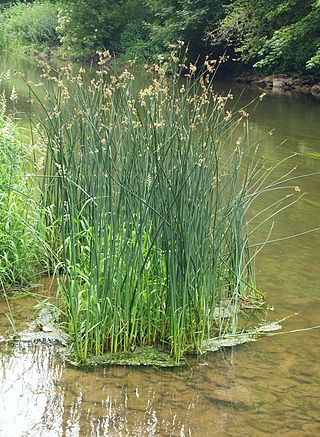
Schoenoplectus lacustris, the lakeshore bulrush or common club-rush, is a species of club-rush that grows in fresh water across Europe and some neighbouring areas.
















